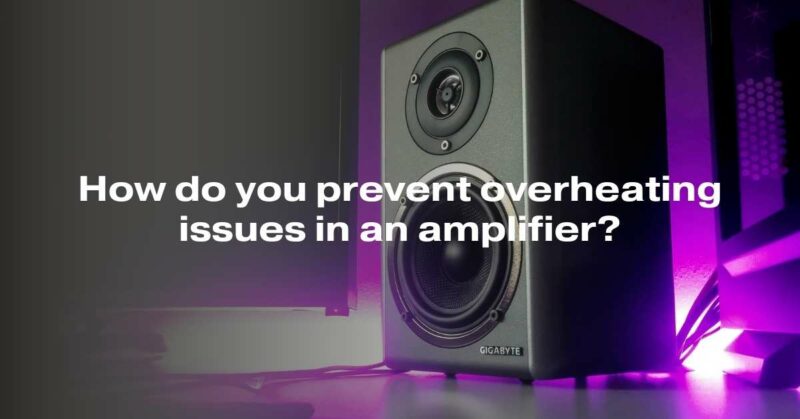Amplifiers play a crucial role in enhancing the audio experience, whether in a home audio system, a car stereo, or professional sound setups. However, one common problem that plagues amplifiers is overheating. Overheating can lead to reduced performance, damage to components, and even amplifier failure if not addressed promptly. In this comprehensive guide, we will explore the various factors contributing to amplifier overheating and provide practical tips on how to prevent and mitigate this issue.
Understanding Amplifier Overheating
Amplifier overheating occurs when the internal components of the amplifier generate excessive heat that cannot be effectively dissipated. This heat buildup can lead to several adverse consequences, including:
- Reduced Lifespan: High operating temperatures can significantly reduce the lifespan of amplifier components, including transistors, capacitors, and resistors.
- Sound Quality Degradation: Overheating can cause distortion and reduced audio quality due to the increased resistance and impedance of components.
- Thermal Shutdown: Many modern amplifiers are equipped with thermal protection mechanisms that shut down the amplifier when it reaches a certain temperature. While this prevents catastrophic failure, it can be disruptive if it happens during a critical moment.
- Fire Hazard: In extreme cases, amplifier overheating can lead to a fire hazard, posing a risk to both the equipment and the surrounding environment.
Common Causes of Amplifier Overheating
Before delving into prevention strategies, it’s essential to understand the common causes of amplifier overheating:
- Inadequate Ventilation: Poor ventilation is a primary cause of overheating. When an amplifier is placed in a confined space or with limited airflow, heat cannot dissipate effectively.
- Impedance Mismatch: Running an amplifier at an impedance lower than its rated minimum can strain the amplifier, leading to excessive heat generation.
- Overloading: Pushing an amplifier beyond its power limits, often in an attempt to achieve higher volume levels, can result in overheating.
- Dust and Dirt: Dust and dirt accumulation inside an amplifier can insulate components and impede heat dissipation.
- Overuse: Continuous operation at high volumes for extended periods can lead to overheating.
- Suboptimal Design: Some amplifiers are poorly designed or lack adequate cooling mechanisms, making them more prone to overheating.
Preventing Overheating Issues
Now that we’ve identified the common causes of amplifier overheating, let’s explore preventive measures to keep your amplifier running cool and performing optimally:
- Proper Ventilation:
a. Ensure Adequate Space: Place the amplifier in a well-ventilated area with enough space around it to allow for free airflow.
b. Rack-Mounted Amplifiers: If your amplifier is rack-mounted, use rack-mounted cooling fans to improve airflow.
- Impedance Matching:
a. Always use speakers and components with the correct impedance ratings that match those of the amplifier.
b. Avoid using speakers with impedances significantly lower than the amplifier’s minimum rating.
- Avoid Overloading:
a. Respect Power Ratings: Adhere to the manufacturer’s recommended power ratings and avoid pushing the amplifier beyond its limits.
b. Use an External Limiter: Employ an external limiter or compressor to prevent signal peaks from overloading the amplifier.
- Regular Maintenance:
a. Cleanliness: Keep the amplifier and its surroundings clean from dust and debris. Use compressed air to remove dust from internal components.
b. Inspect Wiring: Periodically inspect and tighten all connections and wiring to ensure proper conductivity and minimize resistance.
- Rest Periods:
a. Give your amplifier regular breaks, especially during extended usage, to prevent excessive heat buildup.
- Cooling Solutions:
a. Use Cooling Fans: Install cooling fans or heatsinks to enhance heat dissipation.
b. Amplifier Placement: Avoid stacking amplifiers or placing them on top of other heat-producing equipment.
- Thermal Protection:
a. Invest in amplifiers equipped with built-in thermal protection mechanisms to safeguard against overheating-related damage.
- Monitoring:
a. Employ monitoring tools or devices that measure the amplifier’s temperature and provide warnings or shut down the unit if it becomes too hot.
Conclusion
Amplifier overheating can be a serious issue, leading to reduced performance, damage, and even safety hazards. Preventing overheating requires a combination of proper setup, maintenance, and usage practices. By following the guidelines outlined in this comprehensive guide, you can ensure that your amplifier operates efficiently, maintains its longevity, and delivers the high-quality audio experience you desire. Remember that prevention is key, and taking proactive measures can save you from the headache of dealing with overheating issues in the future.

